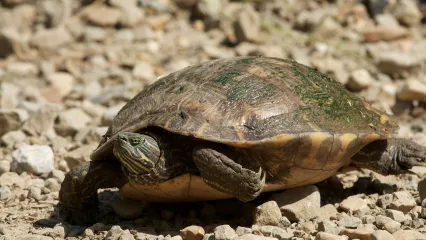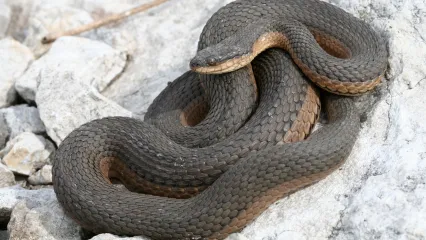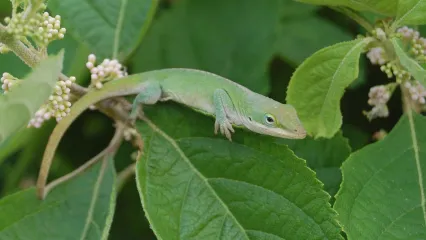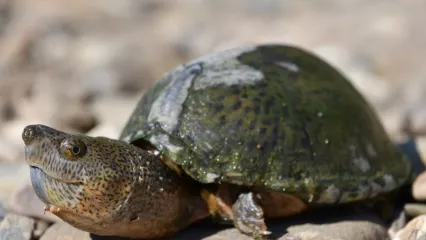
Description
Eastern river cooters, also known as gulf cooters, are the largest emydid turtles in Oklahoma. Toes are webbed on hind- and forelegs and the shell is relatively low in profile, smooth, and with no mid-dorsal ridge. The plastron has no hinges and is large. Background color of the carapace and skin is dark green. The carapace has an intricate pattern of orange to yellow curved lines that form half circles and circles on some scutes. The center of each marginal scute has a vertical yellow or orange line. Where marginal scutes come together, light circles with a center light spot exist. Dark, circular marks, as circles within circles, are present on the underside of marginals. A series of yellow lines run back from the eyes and along the top of the head, but there are no enlarged blotches of color on the neck as in the red-eared slider and the Ouachita map turtle. The plastron is yellow with dark markings that fade with age.
Size
Large adult eastern river cooters can reach 15 inches in carapace length and females are much larger than males. Hatchlings are a little less than one and one-half inches in carapace length.
Habitat
Eastern river cooters occur in rivers, large streams, lakes, and occasionally ponds across eastern Oklahoma, but extend into central Oklahoma along major river systems in the northern and southern parts of the state. In North America, the west–east distribution extends from south-central Oklahoma to Virginia and north–south from central Kansas to the gulf coast. Isolated populations exist in the Rio Grande River of southeastern New Mexico and the Rio Grande Valley of Texas as well as central-west Florida.
Life Cycle
Eastern river cooters are aquatic turtles that leave the water only to locate other aquatic habitats or to lay eggs. They frequently bask and, as a result, they are one of several species that are often lined up on logs in rivers, streams, and lakes. They are herbivorous, feeding on a variety of aquatic vegetation. Mating likely occurs in spring. Sexual dimorphism is evident with males being much smaller in size and having much longer claws on the front limbs than females. The long claws are used during courtship, which occurs in the water. Females reach sexual maturity at a size of about 9 inches in plastron length and deposit two or three clutches of eggs each season. Clutch size is variable depending on size of the female. In general clutches vary from as few as nine to as many as 30 eggs. First clutches are deposited in May and the incubation period lasts about 85 days. These turtles can live 40 years or more.
How To Observe
During spring, summer, and fall, these turtles bask on logs and rocks and are easy to observe using binoculars. During early summer, they can occasionally be observed crossing roads when females search for nesting sites.
(This profile was created by Dr. Laurie Vitt as part of a partnership between the Wildlife Department and the Sam Noble Oklahoma Museum of Natural History. It was funded as part of a larger State Wildlife Grant to survey and inventory amphibians and reptiles of the Wildlife Management Areas of Oklahoma: T-35-P-1.)


